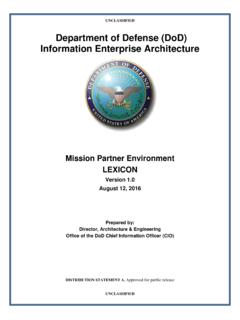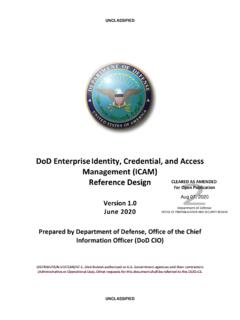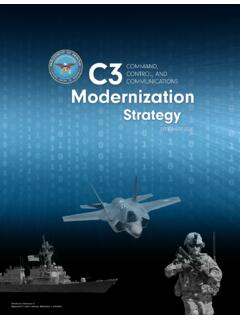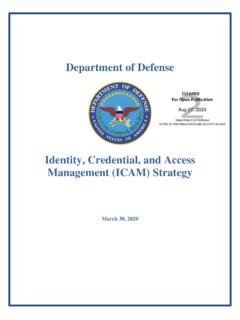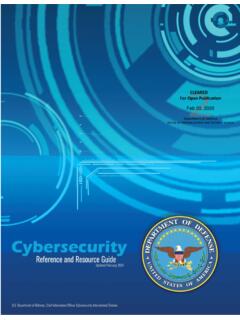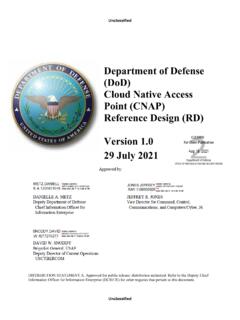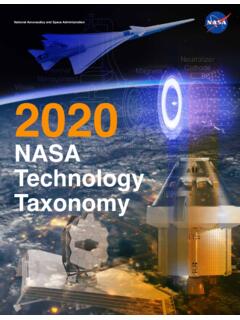Transcription of DoD IT Enterprise Strategy and Roadmap
1 DoD IT Enterprise Strategy and Roadmap Department of Defense (DoD) Information technology (IT) Enterprise Strategy and Roadmap Version 6 SEP 11 September 2011 DoD IT Enterprise Strategy and Roadmap iii DoD IT Enterprise Strategy and Roadmap iv Foreword The number of networks the Department of Defense (DoD) uses to execute its missions has increased significantly over the past 30 years. Although these networks have proved vital to DoD s success, the incremental and evolutionary manner in which DoD develops information technology (IT) has resulted in layers of stove-piped systems that are difficult to integrate and not as effective as needed. Although DoD s IT infrastructure enables warfighters to operate effectively in the twenty-first century, the unnecessary complexity of our networks and IT reduces our ability to secure our information systems, hampers our ability to share information, and needlessly consumes the finite resources available to DoD.
2 This untenable situation requires us to make dramatic changes in how we develop, implement, and sustain IT across DoD. Together, we must modify existing processes to reduce complexity and optimize our networks for the joint environment. Our goals are to dramatically increase our cyber security posture, increase our effectiveness across joint and coalition lines, and reduce the resources our networks consume. This document is our Strategy and Initial Roadmap to achieve these goals and deliver a streamlined, rationalized, and simpler network by consolidating IT infrastructure across DoD. As such, this document also aligns with the Chief Information Officer (CIO) 25 Point Implementation Plan to Reform Federal Information technology Management , particularly its call for enhanced operational efficiency.
3 Through this Strategy , we are committing to a task that requires changes to policies, cultural norms, and organizational processes to provide lasting results. We will focus initially on obtaining tangible results in Fiscal Years (FY) 2011 2012 and plan for aggressive consolidation through FY2015. Aggressively consolidating now will better position us to embrace emerging technology and provide cutting-edge service to our warfighters. This aggressive consolidation cannot, however, come at the price of degraded capabilities for the warfighter or inflexible commitment to a specific technological solution. Accordingly, this Strategy and Roadmap is intended to provide DoD with sufficient flexibility to respond to and incorporate emerging technology and to identify and take appropriate actions for those efforts that are not producing.
4 Our focus remains, as it always has been and always will be, on providing the military forces needed to deter war and to protect the security of our country. This effort will be a collaborative undertaking in which I will work side-by-side with DoD s Component CIO or equivalent IT leads to plan and execute this Roadmap and to strengthen the partnerships between the DoD CIO s office and the offices of the Under Secretary of Defense for Acquisition, technology & Logistics (USD(AT&L)), Director Cost Assessment and Program Evaluation (D, CAPE), Under Secretary of Defense Comptroller (USD(C)), and Deputy Chief Management Officer (DCMO) to affect long-term change. I look forward to leading DoD through this consolidation effort and delivering a better DoD Information Enterprise in the immediate future.
5 //signed// Teri M. Takai DoD Chief Information Officer DoD IT Enterprise Strategy and Roadmap v Executive Summary Historically, DoD s information technology (IT) investments have been made to meet the needs of individual projects, programs, organizations, and facilities. This decentralized approach has resulted in large cumulative costs and a patchwork of capabilities that create cyber vulnerabilities and limit the ability to capitalize on the promise of new developments in IT. In August 2010, the Secretary of Defense directed the consolidation of IT infrastructure to achieve savings in acquisition, sustainment, and manpower costs and to improve DoD s ability to execute its missions while defending its networks against growing cyber threats.
6 Specific direction was received to consolidate IT infrastructure to optimize for the joint environment and to pursue consolidation in a way that does not preclude future consolidation of IT infrastructure at the DoD Enterprise level. During the first quarter of FY 2011, more than 240 representatives from the Office of the Secretary of Defense (OSD), the Military Departments, Defense Information Systems Agency (DISA), National Security Agency (NSA), and United States Cyber Command (USCYBERCOM) analyzed opportunities to consolidate DoD IT infrastructure through specific initiatives in five functional areas: Network Services, Computing Services, Application & Data Services, End-User Services, and IT Business Processes.
7 Detailed descriptions, initial implementation timelines, and rough-order-of-magnitude (ROM) estimates of the required investments and potential savings were developed for 26 initiatives. Each initiative contributes to one or more of the IT Enterprise goals increase mission effectiveness, improve cyber security, and deliver efficiencies. Preliminary estimates are that this initial set of initiatives will deliver efficiencies of between $ billion and $ billion annually by FY2016 and between $ billion and $ billion over the Future Years Defense Program (FYDP). This effort already has resulted in a direct budget reduction of $ billion across the FYDP in the FY2012 DoD submission to the President s Budget through specific IT consolidation actions by the Air Force ($ billion) and the Army ($500 million).
8 The DoD Chief Information Officer (CIO) Executive Board (CIO EB) is DoD s senior functional oversight body for IT infrastructure and will be the focal point for IT consolidation governance. DoD IT Enterprise Strategy and Roadmap vi The Components progress against their IT consolidation performance measures will be reported through the CIO EB to the Deputy s Advisory Working Group (DAWG) and the Defense Business Systems Management Committee (DBSMC) as appropriate. Specific changes to DoD s three core processes Joint Capabilities Integration and Development System (JCIDS), Planning, Programming, Budgeting and Execution (PPBE), and Defense Acquisition System (DAS) are required to address the systemic conditions that lead to DoD s stove-piped IT infrastructure.
9 The DoD CIO will work with the core process owners to implement the required changes. These efforts will be synchronized with the parallel DoD activities under way to reform DoD IT acquisition. Effective communication is critical to building the DoD-wide commitment that will be required to optimize DoD IT infrastructure for the joint environment. This document is the initial communication of the Secretary s intent and will be followed by communications that detail associated policy, performance measures, architectures, and standards. DoD IT Enterprise Strategy and Roadmap vii Table of Contents 1 Introduction .. 1 2 Background .. 2 3 Vision for a more Effective, Efficient and Secure DoD Information Enterprise .
10 4 Improving Effectiveness .. 4 Improving the Information Security Posture .. 5 Enabling Efficiencies .. 5 4 IT Enterprise Strategy .. 6 IT Enterprise Goals .. 6 Improve Mission Effectiveness .. 7 Improve Cyber Security .. 8 Deliver Efficiencies .. 8 Governance .. 9 Management Approach .. 10 Initial Performance Metrics .. 11 Communications Plan .. 11 5 IT Enterprise Roadmap .. 13 Initial Consolidation Initiatives .. 15 Network Services (NS) .. 16 Computing Services (CS) .. 16 End-User Services (EUS) .. 18 Application and Data Services (ADS) .. 19 IT Business Processes (BP) .. 21 6 Estimated Efficiencies .. 22 7 Sustaining Processes .. 24 IT Governance .. 24 Certification and Accreditation (C&A).
